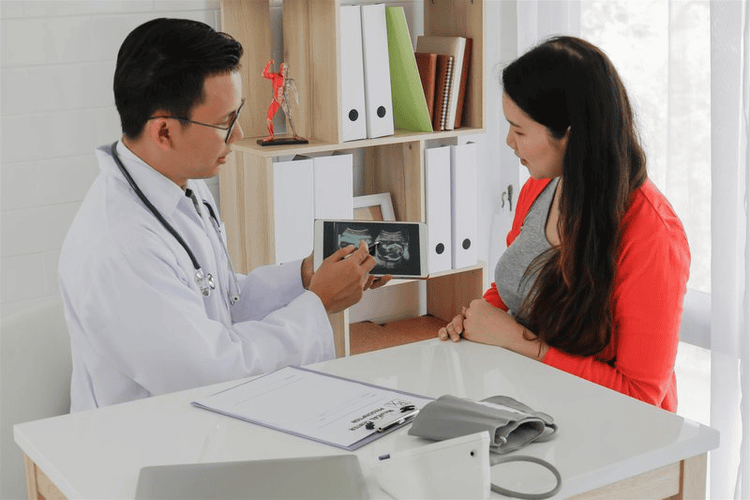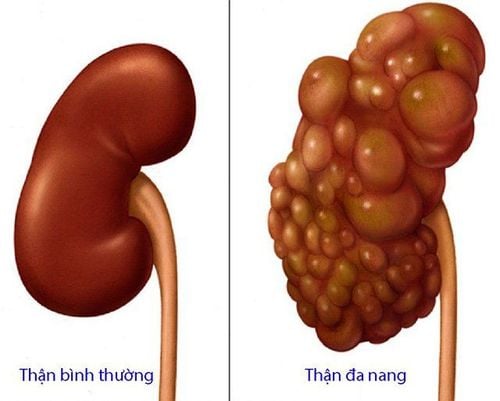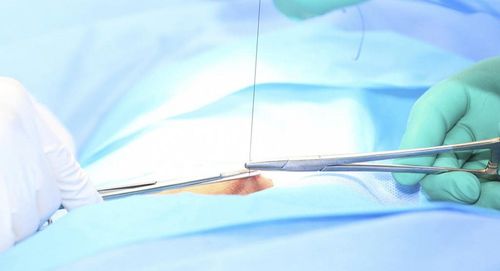This is an automatically translated article.
The article is professionally consulted by Master, Doctor Nguyen Van Thanh - Obstetrician and Gynecologist - Department of Obstetrics and Gynecology - Vinmec Ha Long International HospitalFetal ultrasound is the best way to detect the cause of renal dilatation in the fetus. It is during each milestone of pregnancy that through ultrasound the baby's urinary system abnormalities will be detected based on the amount of amniotic fluid of the mother.
1. What is fetal renal dilatation?
The fetal renal pelvis is usually < 4 mm before 19 weeks, < 5 mm before 29 weeks, and < 7 mm after 30 weeks. Therefore, if this index is higher than normal, it is considered that the fetus has dilated renal pelvis. However, the initial evaluation should be re-evaluated after 30 minutes because renal dilatation may be transient. The mild cases of renal pelvis dilatation in the fetus will stabilize or regress in the neonatal period.Renal dilatation in the fetus is also a warning sign of Down syndrome in the baby if they appear with other abnormal signs.
2. Is renal dilatation in the fetus dangerous?
Almost when hearing about fetal pyelonephritis, pregnant women will think it is a dangerous phenomenon, but the truth is that most cases only need to be monitored by ultrasound during 40 weeks of pregnancy.Pregnant women always keep a happy mood to enjoy the joy of pregnancy because basically the pregnancy process, due date, delivery method will not be affected by this condition. Mothers just need to keep in mind the condition of their baby to notify the prenatal ultrasound doctor every time they go for a checkup.
After the baby is born, the neonatologist will examine the baby, the purpose is to detect birth defects if there are any such as undescended testicle, inguinal hernia...

3. Causes of renal pelvis dilation in the fetus
There are many causes of renal pelvis dilatation in the fetus, but most of them have no specific cause. Basically, some causes can be listed as follows:3.1 Physiological renal dilatation Renal dilatation is only transient at the time of ultrasound. Most cases of renal dilatation detected from the fetal period are in this category. The dilation will not increase or improve over time, possibly up to a few years after the baby is born.
3.2 Renal dilatation due to ureteral obstruction Usually there are 2 possible sites of obstruction in the urinary tract. The most common site is at the junction between the renal pelvis and the ureter.
3.3 Urethra Obstruction A long-term urethral obstruction will cause the bladder to stretch, not contract to push urine out, gradually affecting the ureters and renal pelvis of the fetus.
3.4 Kidney - double ureter Usually each person has only one kidney, one ureter on one side of the body. However, about 1% of all people have more than one ureter that originates in the kidney, a condition known as nephrogenic diuresis. Most have no symptoms and do not affect health.
However, obstruction of the ureter and accessory kidney, usually above the main kidney, may occur in 1 in 5,000 children. Prenatal ultrasound can show partial dilation of the kidney. This accessory ureter is often blocked at the site of ectopic emptying into the bladder, causing a tortuous dilatation of the ureter and an aneurysm pressing into the bladder lumen.
3.5 Polycystic kidney Polycystic kidney is caused by a complete blockage of the ureter from the fetal period, the polycystic kidney cannot excrete urine and does not develop normally. Usually only one kidney is present, and the other kidney often overgrows to compensate so overall kidney function remains perfectly normal.
3.6 Vesicoureteral reflux This condition occurs in 5-25% of cases of renal dilatation before birth, vesicoureteral reflux is a condition in which urine can travel from the bladder to the ureter due to loss of urine. Anti-reflux mechanism of the ureteral emptying site into the bladder.
Prolonged reflux can dilate the ureters and renal pelvis and put the child at high risk of urinary tract infections, requiring prophylactic antibiotics within the first year of life.
4. How to cure dilated renal pelvis in fetus

4.2 Postpartum follow-up After the baby is born, in major maternity hospitals, there are always neonatologists who will examine the baby, the purpose is to detect birth defects early if any (hidden testicles, low urinary tract, inguinal hernia,...).
The baby should have an ultrasound to check for urinary tract birth defects within the first week after birth, preferably on the 3rd day to assess the degree of renal dilatation and urinary obstruction. Ultrasound should not be carried out too early, because in the first few days, there will be physiological dehydration, the renal pelvis may shrink by itself, so it does not reflect the correct medical condition if any. Based on the ultrasound results, the pediatrician will evaluate and recommend the appropriate treatment.
Accordingly, children with vesicoureteral reflux may need prophylactic antibiotic therapy to prevent urinary tract infections. However, it is also possible that the child will need surgery if there are obvious signs of urinary tract obstruction, ultrasound examination detects worsening renal dilatation, combined with symptoms of recurrent urinary tract infections. over and over again.
For children with polycystic kidney disease, the other kidney is mostly normal and fully functional. Unless this kidney causes symptoms, affecting the child's development, it can be treated conservatively, without surgical intervention when the child is too young. Your doctor will monitor your kidney condition for 6 months to a year and decide to remove it when the time is right.
The most important thing is that pregnant women need to keep an optimistic spirit and have antenatal checkups according to the doctor's appointment to have a smooth delivery.
To protect mother and baby's health comprehensively, Vinmec International General Hospital now has a full maternity service, with a team of highly qualified doctors, ultrasound system, and medical equipment. Modern equipment will promptly recognize abnormalities during pregnancy, help monitor the health of mother and baby right from the beginning of pregnancy, early detect and intervene in time health problems.
After birth, the baby will be cared for in a sterile room before being returned to the mother. Pregnant women will be rested in a high-class hospital room, designed according to international hotel standards, one mother per room with fully equipped and modern facilities. Mothers will be consulted by nutritionists on how to feed the baby before being discharged from the hospital. Postpartum follow-up with both mother and baby with leading Obstetricians - Pediatricians.
Please dial HOTLINE for more information or register for an appointment HERE. Download MyVinmec app to make appointments faster and to manage your bookings easily.














